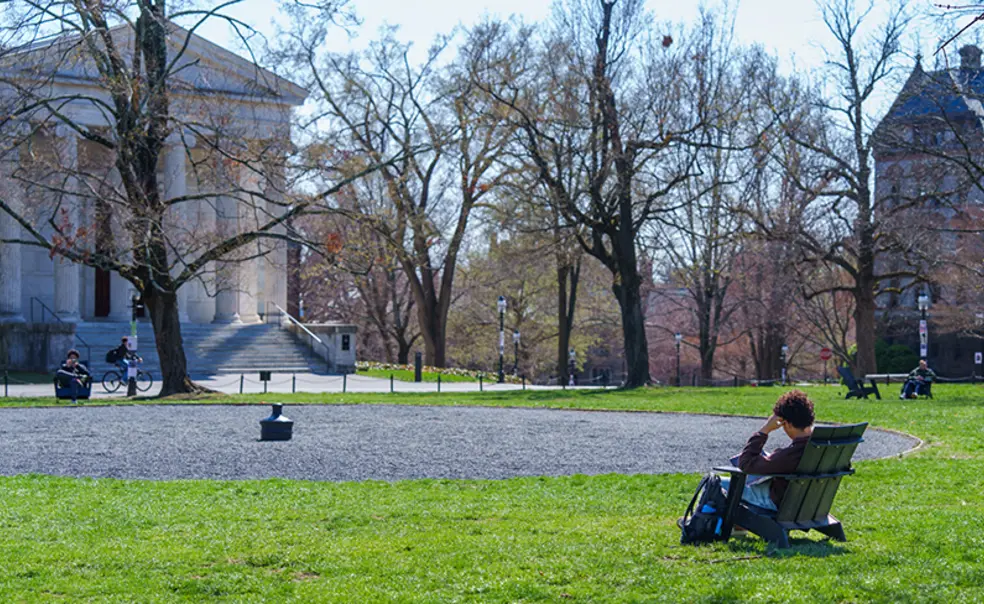Rally ’Round the Cannon: Our Fortunes and Our Sacred Honor
Someone said to me, “Cheer up. Things could be worse.” So I cheered up, and sure enough, things got worse. — Curly Howard of the Three Stooges
Last time around the Quad, you may recall, we reflected on the current friction between the U.S. higher education community and what purports to be an American government occupying space in the District of Columbia. President Chris Eisgruber ’83 had opined this was the most adversarial the two camps had been since the last Red Scare in the 1950s, and we recalled some of Princeton’s and the government’s behavior at that time. There seemed, upon reflection, plenty of tepid, if not cowardly, behavior on many sides during that chapter in history, allowing the psychotics to persist, at least for a while. This was very bad.
But underneath, I was also thinking back to the prior collegiate/government contretemps, by far the worst of all. The outcome was just as emphatic, but the conflict involved in achieving it was hugely more wrenching and dangerous. So today we reconsider a few salient points about the cataclysmic American Revolution, not so much about the landed gentry debating in Philadelphia who came out of it with a country and a Constitution, but the everyday townspeople — and institutions, like colleges — who got embroiled in the dirty work of making it happen.
After the British victory in the French and Indian War in 1763, Parliament decided to keep a military garrison in the United States. They never asked, and it wasn’t a big hit to begin with, especially in more settled New England, but the proviso that the colonists should foot the bill for the unrequested privilege struck a raw nerve everywhere.
Parliament passed the Stamp Act to raise these funds in the colonies in March 1765, involving surcharges of startlingly precise gradation on various paper documents and contracts, the preponderance of which fell on legal, publishing, and educational institutions. Ostensibly raising money to be spent on protection, it also included more than a whiff of both discouraging a homegrown American professional and manufacturing class and furthering the authority of the Anglican church. Essentially every word of the Stamp Act was in blatant contravention to the Princeton College’s interest. A continentwide Congress including New Jersey delegates was called for in New York to compile complaints to the Crown, the first such gathering ever; it eventually drew up a statement of rights, forwarding it to Parliament and young King George III in protest of the act. This dress rehearsal saved substantial time in preparations for the First Continental Congress nine years later, when the focus had dramatically changed to independence. Meanwhile at Princeton, the protest mantle had been claimed by the 31 graduating students (student unrest: you’re shocked, surely…) who concocted a great PR effort by eschewing their fancy British duds and wearing only homespun clothing of American manufacture to their graduation. Their orations were entitled Patriotism, Liberty, Frugality, and Industry. It was a great press sensation across the colony and beyond. The Stamp Act was repealed in March 1766.
So of course, the British learned from the experience, withdrew the unwanted soldiers and supported the further economic enhancement of the colonies in service of Mother England, right? Of course not. Parliament in 1768 passed the Townshend Acts, instituting tariffs on various goods imported from England (where have we heard that one before?), to the howling of various colonial legislatures. Troops moved into Boston. By March 1770 things were at fever pitch, and the resulting Boston Massacre was next to inevitable in some form. The aftermath reverberated through the colonies; the undergrads intercepted a letter from New York to Philadelphia merchants trying to subvert the resultant import boycott, then burned it in a public ceremony with a hangman hired for the occasion. The homespun clothing made its second appearance at Princeton’s Commencement that September. James Madison was a junior then, Aaron Burr Jr. a sophomore.
The Townshend Acts were repealed, but the tea tax was not. The resulting Boston Tea Party of December 1773 was followed by Princeton students in January seizing and burning a pile of tea from the steward, and with it an effigy of Massachusetts Royal Governor Hutchison, whose refusal to send the tea home precipitated the mess. It turned out the bonfire leader was senior Samuel Leake 1774, hands down the best scholar in the class, and while all the participants got what amounted to a wrist slap from the sympathetic faculty (including President John Witherspoon), he was made salutatorian. The trustees desperately tried to restore decorum by canceling the honor and chastising the faculty in a meeting that included ex officio Royal Governor William Franklin. Two years later (with full trustee support), Witherspoon and the New Jersey legislature would arrest Franklin.
From this point on Witherspoon, the Scots cleric, was unabashedly revolutionary; he began publishing pamphlets addressing e.g. Thoughts on American Liberty. And in May 1776, he knocked down the artificial barrier between his academic and political causes as he went to the pulpit and delivered his first revolutionary sermon, The Dominion of Providence Over the Passions of Men, essentially dedicating the College to the patriot cause. Since religious freedom — crucially, the freedom of each reasoning individual, he contended — was dependent entirely on civil liberty, and because of the impingement of the British on the Colonies (including most especially in his mind the hated Anglican church), the struggle was necessary.
The next academic year opened in the fall of 1776 amid a full-scale war, with the British 50 miles away, burning Witherspoon in effigy among others. The day everything changed was Nov. 29. Witherspoon called the College together, told them to leave, and wished them Godspeed. Students a distance from home were forced to leave everything behind. One 16-year-old student was arrested on the way home and nearly hanged. Washington’s ragtag army whisked through in retreat on Dec. 2; the British showed up five days later. They gleefully pillaged the town in “20 days’ rage” (as it became known), arresting and incarcerating with abandon, wrecking estates including Robert Stockton 1748’s Morven, and trashing a good portion of Nassau Hall, while stabling horses in the basement and imprisoning townspeople above. Stockton was held on a ship in New York, his health destroyed. The British didn’t even bother to assemble troops when the Americans pulled off their fabled raid on the Trenton Hessian barracks on Dec. 25. Finally, on Jan. 3, 1777, the garrison moved out to face the rebels on the Princeton battlefield, which then expanded to include Nassau Hall itself. It changed hands three times that day, and whatever had been spared earlier was destroyed by weapons from swords to muskets to cannon. The losing British retreated to winter in New Brunswick (talk about your consolation prize…) but the Americans kept a skeleton force in the building, doing at least as much damage in five months as the British had done beforehand. When a smattering of students reassembled in the spring, Nassau Hall was totally unusable; they held forth in the president’s house next door. Seven men received their degrees in August 1777, but the entire town, including the church, was still in shambles, and there was no ceremony. In the end, the triumph over oppression that virtually the entire college had been advocating for years had been achieved, but the cost was appalling.
Even laying the psychic damage of the Revolution to the side — 10 of the 600 alumni died, and numbers suffered personal damages similar to those in Princeton — the physical recovery from the war was arduous, reflected primarily in the College’s finances, its operating equipment, and most obviously the condition (or lack of same) of Nassau Hall. Witherspoon’s position enabled the College to wangle a $20,000 Congressional grant in 1779, but a long delay in receiving the cash subjected it to a huge inflationary surge, leaving it worth perhaps 5% of its previous buying power. When added to other earnings and tiny donations, it enabled the minimal reoutfitting of the first two floors of the building, but even as the Congress met in Nassau Hall in 1783 with George Washington and all the biggies, the building was still only half usable. And keep in mind Congress itself was only there because it was evading troops to whom it owed money, and had cancelled cash payments on its bonds, a crucial holding of the College. Witherspoon’s valiant recruitment efforts began to bring in more paying students — enrollment, 150 or so in the early 1770s, sunk to about two dozen in 1780, then rose over the decade to almost 200.
So only in 1791 was the desperately needed new Nassau Hall roof installed and the final reglazing complete, although the new interior was Spartan to a fault, and the yard outside still in shambles. Basement rooms were reconstructed in the advent of more students. In 1796, the trustees mounted an all-out assault on the state legislature (painting a picture of New Jersey as the Athens of America) for funding to bring the College facilities up to par. The result was $4,800, payable by 1798, notable still as the only cash grant ever received directly by the trustees from the state. It was used in the main for new scientific equipment to replace and upgrade that destroyed in the war. Ironically, most of it came from Britain, and much had to be made to order. Princeton’s dedication to freedom from political oppression had led to 25 years of parsimony and countless missed chances to bloom and thrive, but it would now finally be able to fulfill its potential.
But some of the new equipment had yet to arrive when, on March 6, 1802, the restored Nassau Hall burnt to the walls.












No responses yet